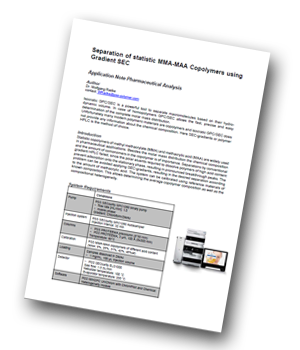 PSS has produced an application note describing how gradient SEC is the method of choice for characterizing statistic copolymers of methyl methacrylate (MMA) and methacrylic acid (MAA) that are widely used in pharmaceutical applications.
PSS has produced an application note describing how gradient SEC is the method of choice for characterizing statistic copolymers of methyl methacrylate (MMA) and methacrylic acid (MAA) that are widely used in pharmaceutical applications.
Introduction
Isocratic GPC/SEC is a powerful tool to separate macromolecules based on their hydrodynamic
volume. In the case of homopolymers, GPC/SEC allows the fast, precise and easy determination of the complete molar mass distribution.
Unfortunately many modern polymeric materials are copolymers and isocratic GPC/SEC does
not provide any information about the chemical composition. Here SEC-gradients or polymer
HPLC is the method of choice. Besides the molar mass distribution, the chemical composition and the amount of comonomers in the copolymer is of importance. Separations by conventional gradient HPLC fail, since the polar eluents required to dissolve polymers of high acid content prevent adsorption onto the stationary phase, resulting in pronounced breakthrough peaks. The problem can be avoided applying SEC-gradients, resulting in the desired separation according to the amount of methacrylic acid.
Results and Discussion
The experimental procedure of SEC-gradients differs from conventional gradient HPLC. While
in conventional HPLC the sample is dissolved in a weak eluent and injected at adsorbing
conditions, the sample is dissolved in a strong mobile phase and injected at the end of the SEC-gradient.
Following separation, a nearly linear dependence between MAA content and elution volume is observed and the use of the calibration curve allows the determination of the chemical composition distribution.




